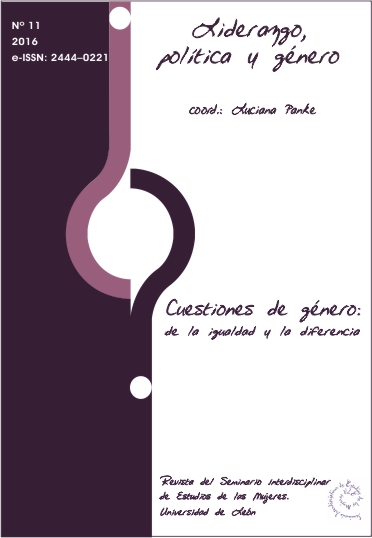Infotainment in the campaign for the 2015 Spanish general election: An analysis of El Hormiguero from a gender perspective
DOI:
https://doi.org/10.18002/cg.v0i11.3608Palabras clave:
Women politicians, general elections, infotainment, stereotypes, sexismResumen
Within the new landscape of political communications characterized by infotainment in prime time television programs, this article analyzes the presence of four political representatives in El Hormiguero to explore if their appearances reinforce gender stereotypes. The analysis of the television programs reveals a substantial progress in the elimination of gender stereotypes which the media traditionally convey and reproduce in political campaigns. The analysis reveals a practical elimination of gendered bias in the interviews; the sexist tone remains, however, in other spaces of the television program linked to humor and entertainment practices.
Descargas
Métricas alternativas
Citas
Baudrillard, Jean (1994): Simulacra and Simulation. Ann Arbor: University of Michigan Press.
Berrocal Gonzalo; Salomé; Redondo García, Marta; Martín Jiménez, Virginia and Campos Domínguez, Eva (2014): “La presencia del infoentretenimiento en los canales generalistas de la TDT española”. In: Revista Latina de Comunicación Social, nº. 69, pp. 85-103.
Camille, Elizabeth and Roberson, Kasie M. (2010): “Playing the Gender Card against a Stacked Deck”. In: Robert E. Denton (ed.): Studies of Identity in the 2008 Presidential Campaign. Lanham: Lexington Books, pp. 65-80.
Castells, Manuel (2009): Communication Power. Oxford and New York: Oxford UP.
Coleman, Stephen (2000): “Meaningful Political Debate in the Age of the Soundbite”. In: Televised Election Debates: International Perspectives. London: MacMillan, pp. 9-11.
Debord, Guy (1995): The Society of the Spectacle. New York: Zone Books.
Devitt, James (1999): Framing gender on the campaign trail: women’s executive leadership and the Press. New York: Women’s Leadership Fund.
Dolan, Kathleen (2015): When Does Gender Matter? Women Candidates and Gender Stereotypes in American Elections. Oxford and New York, Oxford University Press.
Fernández, Eduardo (2015): “Albert Rivera no puede con Pablo Iglesias en las ‘elecciones’ de ‘El Hormiguero’. In: El Mundo, 25 de noviembre de 2015, [on line] Available at: http://www.elmundo.es/television/2015/11/25/56559acf22601de6068b45b0.html [24/12/2015].
Ferré, Carmen (2013) (ed.): Infoentretenimiento. El formato imparable de la era del espectáculo. Barcelona: UOC.
Ford, Thomas and Ferguson, Mark (2004): “Social Consequences of Disparagement Humor: A Prejudiced Norm Theory”. In: Personality and Social Psychology Review, vol. 8, nº.1, pp.79- 94.
Groch-Begley, Hannah (2016): “A Comprehensive Guide to Sexist Attacks On Hillary Clinton From The 2008 Campaign”. In: Media Matters for America, [on line] Available at: http://mediamatters.org/research/2016/02/05/a-comprehensive-guide-to-sexist-attacks-onhill/199700 [09/01/2016].
Hayes, Danny; Lawless, Jennifer and Baitinger, Gail (2014):“Who Cares What They Wear? Media, Gender, and the Influence of Candidate Appearance”. In: Social Science Quarterly, nº. 95, pp. 1194–1212.
Lawless, Jennifer L. and Fox, Richard L. (2012): It Still Takes a Candidate. Why Women Don’t Run for Office. New York: Cambridge University Press.
Lenz, Gabriel S. and Chappell, Lawson (2011): “Looking the Part: Television Leads Less Informed Citizens to Vote Based on Candidates’ Appearance”. In: American Journal of Political Science, vol. 55, nº. 3, pp. 574–89.
Lipovetsky, Gilles (2005): Hypermodern Times. Cambridge: Polity Press.
Lockwood, Nancy (2004): “The Glass Ceiling: Domestic and International Perspectives”. In: Research Quarterly, pp. 1-11.
McNair, Brian (1998): The Sociology of Journalism. New York: Oxford UP.
O’Leary, Pamela and Shames, Shauna (2015): “Shattering the Glass Ceiling for Women in Politics”. In: Scholars Strategy Network, [on line] Available at: https://www.scholarsstrategynetwork.org/sites/default/files/ssn_basic_facts_oleary_and_shames_on_shattering_the_glass_ceiling_for_women_in_politics_0.pdf [29/12/2015].
Rodríguez, María Pilar (2012) (ed.): Representaciones de las mujeres políticas en la prensa. Bilbao: Publicaciones de la Universidad de Deusto.
Simelio, Nuria (2015) (coord.): “Proyecto de Monitoreo Global de Medios 2015. Informe Nacional”. In: Who makes the news, [on line] Avaliable at: http://cdn.agilitycms.com/whomakes-the-news/Imported/reports_2015/national/Spain.pdf [19/12/2015].
Thussu, Daya Kishan (2007): News as Entertainment: The Rise of Global Infotainment. Los Angeles, London, New Delhi and Singapore: Sage.
Van Dijk, Teun A (1999): “El análisis crítico del discurso”. In: Anthropos, nº. 186, pp. 23- 36.
Descargas
Publicado
Cómo citar
Número
Sección
Licencia
Derechos de autor 2016 María Pilar Rodríguez Pérez, Miren Berasategi

Esta obra está bajo una licencia internacional Creative Commons Atribución-NoComercial-CompartirIgual 4.0.
L@s autores/as que publican en esta revista están de acuerdo con los siguientes términos:
1. L@s autores/as ceden de forma no exclusiva los derechos de explotación (reproducción, distribución, comunicación pública, transformación) a la Universidad de León, por lo que pueden establecer, por separado, acuerdos adicionales para la distribución no exclusiva de la versión de la obra publicada en la revista (por ejemplo, alojarlo en un repositorio institucional o publicarlo en un libro), con un reconocimiento de su publicación inicial en esta revista.
2. Este trabajo se encuentra bajo la Creative Commons Attribution-NonCommercial-ShareAlike 4.0 International License. Puede consultarse desde aquí la versión informativa y el texto legal de la licencia.
3. Se permite y se anima a l@s autores/as a difundir electrónicamente las versiones pre-print (versión antes de ser evaluada) y/o post-print (versión evaluada y aceptada para su publicación) de sus obras antes de su publicación, ya que favorece su circulación y difusión más temprana y con ello un posible aumento en su citación y alcance entre la comunidad académica.
Cuestiones de Género utiliza exclusivamente la licencia Atribución-NoComercial-CompartirIgual 4.0 Internacional (CC BY- NC-SA 4.0).
Bajo los siguientes términos:
- Atribución: Usted debe dar crédito de manera adecuada , brindar un enlace a la licencia, e indicar si se han realizado cambios . Puede hacerlo en cualquier forma razonable, pero no de forma tal que sugiera que usted o su uso tienen el apoyo de la licenciante.
- No Comercial: Usted no puede hacer uso del material con propósitos comerciales .
- Compartir Igual: Si remezcla, transforma o crea a partir del material, debe distribuir su contribución bajo la la misma licencia del original. cualquier uso permitido por la licencia.
No hay restricciones adicionales — No puede aplicar términos legales ni medidas tecnológicas que restrinjan legalmente a otras a hacer
L@s autores/as pueden consultar los derechos de copyright y las condiciones de autoarchivo en el directorio Dulcinea.










